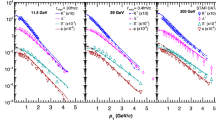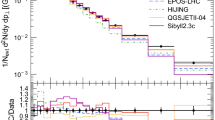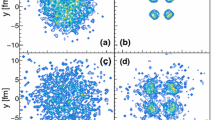Abstract
Strange quark production in relativistic heavy-ion collisions is used as a diagnostic tool as well as a signature for QGP formation. Strong interactions in the QGP medium generate strange quarks and antiquarks which don’t exist in normal matter. The reason being shortly after their production, they undergo decay via weak interactions. Its unique mass which is expected close to the temperature at which protons, neutrons and other hadrons turn into quarks. Hence, these strange quarks, antiquarks are sensitive to the conditions, structure and dynamics of the deconfined state of matter. It can be said that the deconfined state is reached if there is an abundance of strange quarks. In this proceedings we are going to discuss about the different hyperon yields (\(\Lambda , \Xi , \Omega \)) calculated using AMPT and UrQMD model.
Similar content being viewed by others
Explore related subjects
Discover the latest articles, news and stories from top researchers in related subjects.Avoid common mistakes on your manuscript.
1 Introduction
The groundbreaking discovery by Rafelski and Muller [1], who first reported the enhancement of relative strangeness production, has provided a crucial insight into the properties of Quantum Chromodynamics (QCD) [2], the theory that governs the strong nuclear force [3]. This phenomenon, observed in high-energy collisions of heavy ions at the Super Proton Synchrotron (SPS), Relativistic Heavy Ion Collider (RHIC) [4], and Large Hadron Collider (LHC) [5], is considered a signature of a phase transition from ordinary hadronic matter to a new phase known as the Quark-Gluon Plasma (QGP).
Strangeness production [6] which serves an important tool to study the primordial state of matter, which lasted a few microseconds after big-bang. As a final product of high-energy nuclear collision it provides a valuable insight to understand the properties of the system which is created, since strange hadrons [7] are not studied directly they are extrapolated from the outcome of the colliding nuclei. However, the strangeness content remains different in the hardonic matter as well as QGP.
The mass of strange particles is of the same order as the magnitude as \(T_c\) of the phase transition because of which there is a enhancement of these particles in the chemical and thermal equilibrium. Hence, it is considered that the strange and multi-strange particles are good signal to study the deconfined state of matter. strange hadrons are not produced directly by colliding nuclei, they actually produced from the vaccum. Some of the dominant production channels for the production of s\(\overline{\textrm{s}}\) pair is through gluon fusion i.e. gg \(\rightarrow \) s \(\overline{\textrm{s}}\) and the minimum energy required for this mechanism to occur is approximately (\(\sim \)300 MeV) which is quite smaller as compared to generation of other hadronic process like \(\pi + N \rightarrow \Lambda + K (\sim \)530 MeV).
If the QGP exists, the production of strange hadron is expected to be enhanced due to dominance of the gluon channel. The production rates and phase space distributions of the strange particles may reveal different characteristics of the created fireball and thus they have been studied at different accelerators and experiments [8,9,10].
The current study aims to investigate how the production of strangeness from two Monte Carlo event generators (MCEGs) which are AMPT and UrQMD, relying on various hadronization mechanisms, depends on the event charged particle multiplicity and the center of mass energy at two different values \(\sqrt{s_{NN}}\) =14.6 GeV. We discuss the basic principles of these models, their strengths and limitations, and their predictions for strange particle production in heavy-ion collisions. We basically need a comparison of the strangeness production in a non QGP and QGP scenario, where the comparison of these strangeness results to the experimental results, would help us better understand how the strangeness production in these two different event generators with respect to the experimental data. Due to the experimental work still going on this energy with these strange particles the comparison of these two models would be shown in further analysis. Sect. 1 I is on AMPT model where brief description of the model will be discussed. Section 3 discusses UrQMD model and its formalism help-full in the current paper. Section 4 comparison between both the models has been discussed. In Sect. 5, results from both the models will be discussed. Finally in Sect. 6, conclusions and an overview of the general behavior of strange particle production considering the collision energy dependence are presented.
2 AMPT Model
The AMPT (A Multi-Phase Transport) [11] model is a hybrid approach that has been developed to simulate the dynamics of relativistic heavy-ion collisions in high-energy nuclear physics. It is based on the combination of several different models that simulate the different stages of the collision process [12], including the initial nucleon-nucleon collisions, the formation and fragmentation of color strings, the parton scatterings and their subsequent hadronization, and the final hadronic interactions.
At the initial stage, the AMPT model uses a nucleon-nucleon scattering model to simulate the interactions between individual nucleons in the colliding nuclei. This model takes into account the spatial distribution of nucleons in the colliding nuclei and the dynamics of their collisions. After the initial stage, the model simulates the formation and fragmentation of color strings, which represent the long-range interactions between quarks and gluons in the colliding nuclei. The color strings break up into partons, which are then scattered and interact with each other.
Next, the partons undergo a process called hadronization, where they combine to form hadrons. This process is modeled using the Lund string fragmentation model, which describes the fragmentation of color strings into hadrons. Finally, the model simulates the interactions between the produced hadrons, which are predominantly governed by the strong force. This stage is modeled using a hadronic transport model, which takes into account the collisional and scattering processes between the hadrons.
3 UrQMD Model
To simulate heavy ion collisions across a broad energy range, the Ultrarelativisitc Quantum Molecular Dynamics model [13] was designed. Its solution has been based on coupled set of Boltzmann equations for the time evolution of each hadron species. The main inputs for the simulation are the properties of the individual hadrons which are supplemented by the interactions cross section. The cross sections are either fitted to available data are calculated from effective models or taken from the additive quark model.
In the UrQMD [14] transport model the hadron production advances through diverse production mechanism as: (1) The annihilation of a particle to its anti-particle. (2) The excitation and de-excitation of a string. (3) The excitation and de-excitation (decay) of hadronic resonances. For studying the different processes their probability’s are driven according to the reaction cross-section.
Statistical Approach UrQMD incorporates statistical models for the initial state of the collision, such as the wounded nucleon model or the participant-spectator model. These models provide a statistical distribution of the participating nucleons and their properties, such as positions and momenta.
Monte Carlo Sampling The properties of the participating nucleons are sampled using Monte Carlo techniques, taking into account the nuclear density distribution and momentum spectra. The sampled momenta are based on probability distributions determined from experimental data or theoretical models.
Collective Flow The initial momenta are influenced by collective flow phenomena, such as radial and elliptic flow. These flows arise due to pressure gradients in the created system and can be implemented in UrQMD to assign initial momenta to the particles.
4 Comparison Between the Two Models
In the field of high-energy nuclear physics, the AMPT model and UrQMD model are two widely used transport models that aim to simulate the evolution of the heavy-ion collision system. Although they share some similarities, there are also significant differences between the two models that make them suitable for different applications.
One of the key differences between the AMPT and UrQMD models lies in their approach to modeling the early stage of the collision. AMPT incorporates a parton cascade model to simulate the interactions between partons in the initial state [15], allowing for a more detailed description of the formation of the quark-gluon plasma and the evolution of the system in the early stages of the collision. On the other hand, UrQMD [16] starts with a pre-equilibrium phase that assumes the system is thermalized locally and then proceeds with a hadronic cascade.
Another difference between the two models is their treatment of the final stage of the collision. AMPT includes a hadronic cascade model to simulate the interactions between hadrons after the system has undergone a transition from the quark-gluon plasma phase to the hadronic phase. In contrast, UrQMD is a pure hadronic model that does not include a transition to the quark-gluon plasma phase.
In summary, while both the AMPT and UrQMD models are useful tools for simulating heavy-ion collisions, they have different strengths and weaknesses that make them suitable for different applications. AMPT is well-suited for studying the properties of the quark-gluon plasma, while UrQMD is better suited for describing the hadronic phase of the collision.
The production of strange particles, such as kaons, lambdas, and omegas, in heavy-ion collisions is an important probe for studying the properties of the QGP formed in these collisions. The AMPT and UrQMD models are two widely used transport models that aim to simulate the evolution of the heavy-ion collision system and have been extensively used to study strange particle production in these collisions.
In AMPT, the production of strange particles is primarily governed by the coalescence of partons into hadrons in the hadronization phase [17]. The model includes both quark and gluon degrees of freedom and can account for both thermal and non-thermal production mechanisms.
In UrQMD, the production of strange particles is primarily driven by the formation and decay of resonances in the hadronic phase [18]. The model does not explicitly include the QGP phase and assumes that the system starts in a hadronic state.
In conclusion, both AMPT and UrQMD have been successful in reproducing the measured yields and spectra of strange particles in heavy-ion collisions.
5 Results
We compare the predictions of the AMPT and UrQMD models for the production of strange particles in heavy-ion collisions. We focus on the production of \(\Lambda \), \(\Xi \) and \(\Omega \) which are the most commonly studied strange particles. The yield for these hyperons were studied using AMPT and UrQMD model at 14.6 GeV. A statistics of \(\sim \) 0.9M events was used for each model respectively. The study was performed within the pseudorapidity range \(|\eta | < 1\), full azimuthal coverage and for 5 different centrality ranges: 0–10%, 10–20%, 20–30%, 30–40% and 40–50%. Centrality in both the models is calculated using the percentiles of impact parameter distributions. In Fig. 1a, yield of Lambda particle is shown with comparison to both the models where open markers are for AMPT and closed rectangles are for UrQMD, where the yield shows clear dependence over p\(_T\) for both the models. Similarly, Fig. 1b, c show the yield of \(\Omega \) and \(\Xi \) respectively. Both these figures shows suppression of \(\Omega \) and \(\Xi \) production at higher \(p_T\) compared to \(\Lambda \). The observed dependence of yield on \(p_T\) in both models suggests that the strange particles production is influenced by their momentum in both the models. The suppression of \(\Omega \) and \(\Xi \) particle production at higher \(p_T\) compared to \(\Lambda \) particles could indicate different mechanisms at play in the production of these particles.
6 Conclusion
The study of strange particle production in AMPT and UrQMD has been performed for \(\sqrt{s_{NN}}\) = 14.6 GeV. Both the models have been extensively used to investigate the production and evolution of strange particles in such collisions. While both models were able to describe strange particle production at this energy, it is surely on different strengths.Further studies are needed to understand the underlying mechanisms of strangeness production and to identify the optimal model. These findings will contribute to our understanding of the dynamics of strange particle production in high-energy heavy-ion collisions when compared with the results from the experiment. This, further will help us comprehend the above results in a bigger picture.
References
J. Rafelski, B. Muller, Strangeness Production in the Quark - Gluon Plasma
M. Arslandok, S.A. Bass, A.A. Baty, I. Bautista, C. Beattie, F. Becattini, R. Bellwied, Y. Berdnikov, A. Berdnikov , J. Bielcik, et al., Hot QCD White Paper
K. Kajantie, L.D. McLerran, Probes of the quark gluon plasma in high-energy collisions. Ann. Rev. Nucl. Part. Sci. 37, 293–323 (1987)
C. Blume, C. Markert, Strange hadron production in heavy ion collisions from SPS to RHIC. Prog. Part. Nucl. Phys. 66, 834–879 (2011)
S. Margetis, K. Safarik, O. Villalobos Baillie, Strangeness production in heavy-ion collisions. Ann. Rev. Nucl. Part. Sci. 50, 299–342 (2000)
L.W. Chen, C.M. Ko, Z.W. Lin, Strangeness production in relativistic heavy-ion collisions at energies available at the BNL Relativistic Heavy Ion Collider and at the CERN Large Hadron Collider. Phys. Rev. C 72(6), 064903 (2005)
J. Song, X.F. Wang, H.H. Li, R.Q. Wang, F.L. Shao, Strange hadron production in a quark combination model in Au + Au collisions at energies available at the BNL relativistic heavy ion collider. Phys. Rev. C 103(3), 034907 (2021)
J. Adam et al., Strange hadron production in Au + Au collisions at \(\sqrt{s_{_{\rm NN}}}\) = 7.7, 11.5, 19.6, 27, and 39 GeV. Phys. Rev. C 102(3), 034909 (2020)
A. Aparin, STAR recent results on heavy ion collisions. Phys. Part. Nucl. 53(2), 127–134 (2022)
J. Adam et al., Multi-strange baryon production in p-Pb collisions at \(\sqrt{s_\textbf{NN} }=5.02\) TeV. Phys. Lett. B 758, 389–401 (2016)
Z.W. Lin, C.M. Ko, B.A. Li, B. Zhang, S. Pal, A Multi-phase transport model for relativistic heavy ion collisions. Phys. Rev. C 72, 064901 (2005)
Z.W. Lin, L. Zheng, Further developments of a multi-phase transport model for relativistic nuclear collisions. Nucl. Sci. Tech. 32(10), 113 (2021)
S.A. Bass, M. Belkacem, M. Bleicher, M. Brandstetter, L. Bravina, C. Ernst, L. Gerland, M. Hofmann, S. Hofmann, J. Konopka et al., Microscopic models for ultrarelativistic heavy ion collisions. Prog. Part. Nucl. Phys. 41, 255–369 (1998)
H. Petersen, J. Steinheimer, G. Burau, M. Bleicher, H. Stöcker, A fully integrated transport approach to heavy ion reactions with an intermediate hydrodynamic stage. Phys. Rev. C 78, 044901 (2008)
Z. Xu, B.A. Li, L.W. Chen, Strangeness production in heavy ion collisions with the AMPT model. Int. J. Mod. Phys. E 21(1), 1250002 (2012)
J. Steinheimer, M. Bleicher, Sub-threshold \(\phi \) and \(\Xi ^-\) production by high mass resonances with UrQMD. J. Phys. G 43(1), 015104 (2016)
S. Zhang, Y.G. Ma, L.W. Chen et al., Strangeness production in heavy-ion collisions at RHIC and LHC energies with the AMPT model. Phys. Rev. C 102(2), 024902 (2020)
J. Song, W. Zuo, B.A. Li et al., Production of strange particles in heavy-ion collisions at high energies: UrQMD model versus experimental data. Phys. Rev. C 96(5), 054908 (2017)
Author information
Authors and Affiliations
Contributions
AB is my PhD supervisor. She guided me through the research done in this manuscript. We both have reviewed it.
Corresponding author
Ethics declarations
Conflict of interest
The authors declare no competing interests.
Additional information
Publisher's Note
Springer Nature remains neutral with regard to jurisdictional claims in published maps and institutional affiliations.
Rights and permissions
Springer Nature or its licensor (e.g. a society or other partner) holds exclusive rights to this article under a publishing agreement with the author(s) or other rightsholder(s); author self-archiving of the accepted manuscript version of this article is solely governed by the terms of such publishing agreement and applicable law.
About this article
Cite this article
Bhagat, P., Bhasin, A. Strange Particle Production in Au \(+\) Au Collisions at \(\sqrt{s_{NN}} = 14.6\) Gev Using AMPT and UrQMD. Few-Body Syst 64, 69 (2023). https://doi.org/10.1007/s00601-023-01850-9
Received:
Accepted:
Published:
DOI: https://doi.org/10.1007/s00601-023-01850-9





